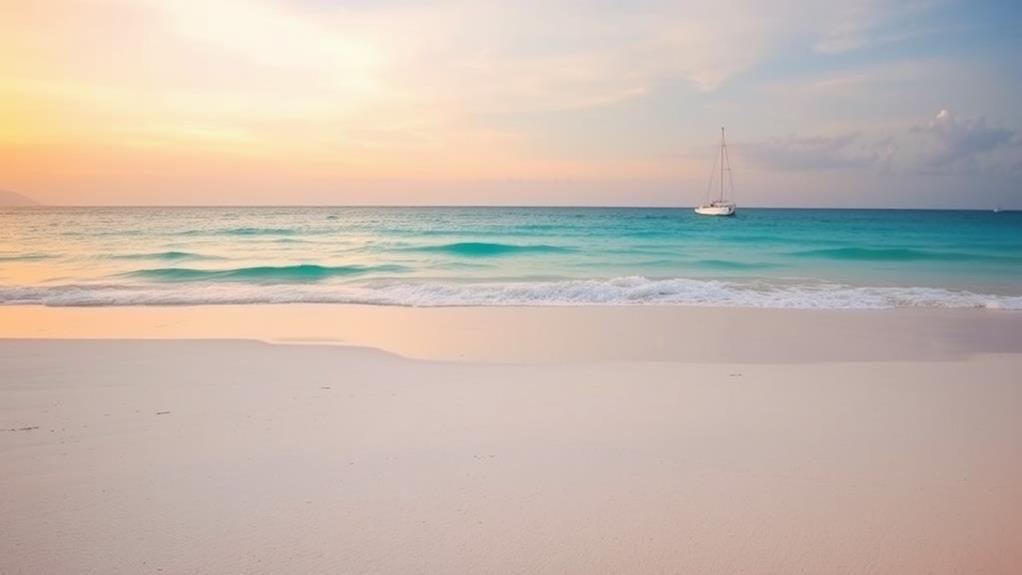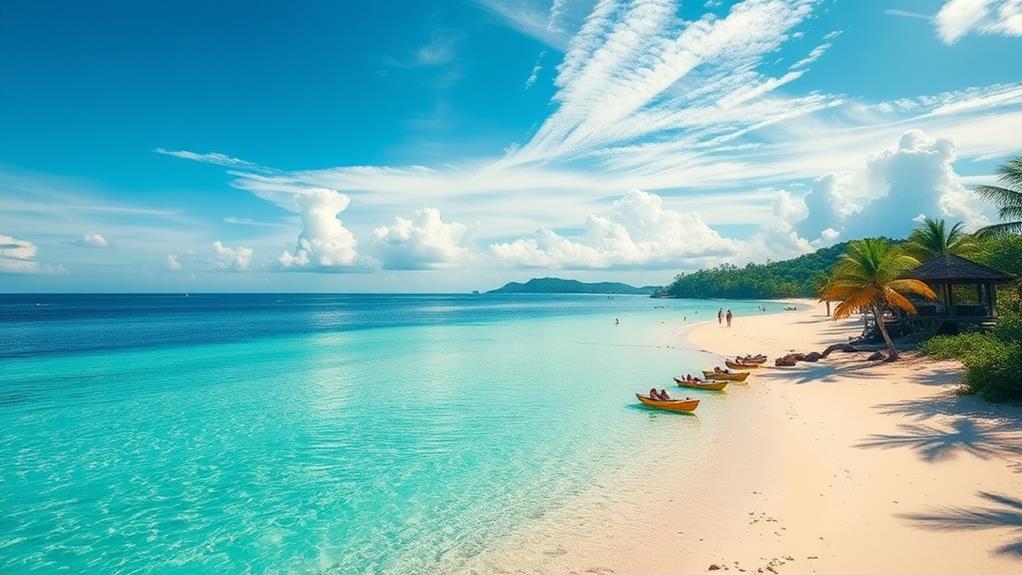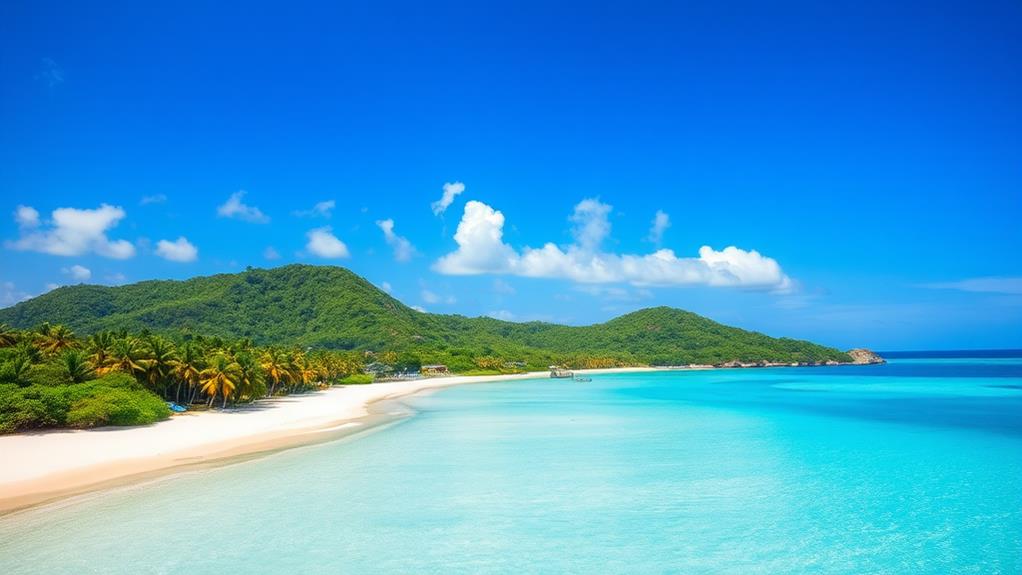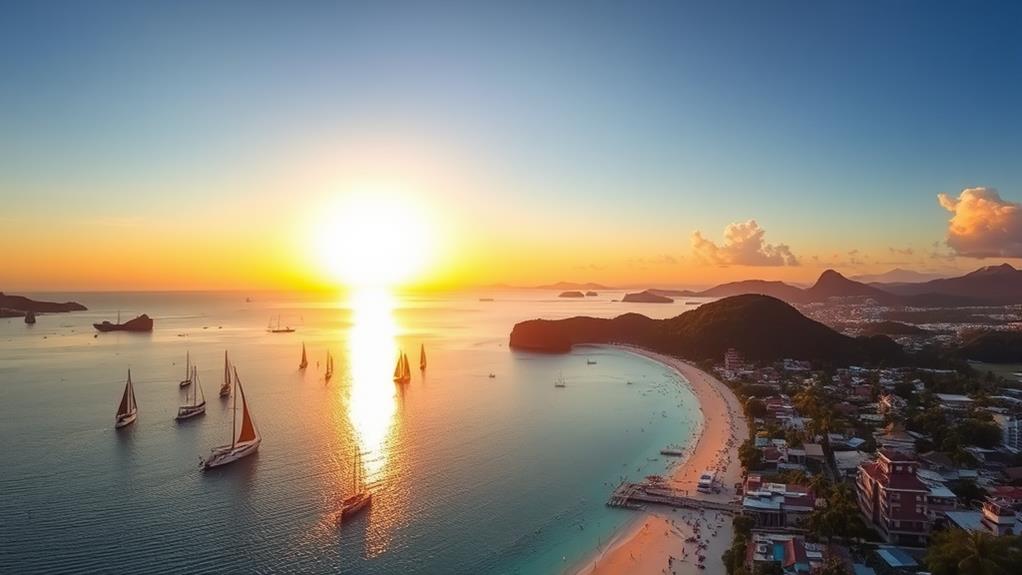Boracay attracts over 2 million visitors annually, making it a Philippine tourism powerhouse. This small island has been transformed by its thriving tourist industry.
The island's 7 km stretch of fine white sand is a major draw, accompanied by crystal clear turquoise waters and a vibrant nightlife scene. This combination makes Boracay a haven for both beach lovers and partygoers. After a day of sunbathing and swimming, visitors can enjoy the plethora of activities available, from water sports to island hopping tours. For those seeking a more serene escape, samal island resorts offer a peaceful retreat and a chance to reconnect with nature. With world-class accommodations and breathtaking views, Boracay truly has something for everyone.
Water sports are a key attraction, with activities like snorkeling, kayaking, and parasailing available.
Local cuisine is another highlight, featuring dishes like seafood paella and grilled fish.
Boracay's diverse attractions cater to all interests, ensuring there's something for everyone. As you explore the island, you'll discover more to this tropical gem than its initial beauty, with hidden wonders waiting to be uncovered.
Pristine Beaches and Crystal Waters

Boracay's Beaches Offer a Unique Sensory Experience
Stepping onto Boracay's shores is a sensory experience unlike any other. The soft, powdery sand beneath your feet, the warm sun on your skin, and the breathtaking sight of crystal clear turquoise waters stretching out before you create an unforgettable atmosphere.
Beaches Cater to Different Preferences
The island's famous 7 km stretch of fine white sand, resembling talcum powder, offers a luxurious walking experience. White Beach, the most popular area, is a must-visit.
For a more serene experience, Diniwid Beach and Angol Beach are hidden gems worth exploring.
Crystal Clear Waters Perfect for Photography and Nature Lovers
The crystal clear waters showcase various shades of blue, making them perfect for photography and attracting nature lovers.
Beaches for Adventure Seekers and Beach Bums
Whether you're a beach bum or an adventure seeker, Boracay's beaches have something to offer. Bulabog Beach, for instance, is a hotspot for water sports, particularly kiteboarding.
Tourism Industry Thrives
With its stunning beaches and coves, it's no wonder Boracay's tourism industry has thrived, attracting over 2 million visitors annually.
Vibrant Nightlife and Entertainment
Boracay's nightlife transforms into a vibrant party hub after sunset. The island offers numerous bars and clubs, each with happy hour deals that attract both local and international party-goers.
As the night wears on, many tourists indulge in late-night festivities, with some venues operating until sunrise, solidifying the island's reputation as a premier party destination.
The nightlife caters to diverse preferences, ranging from lively beach parties to quieter, more intimate settings.
During peak tourist seasons, the island's nightlife is particularly popular, contributing significantly to Boracay's economy and generating substantial tourism receipts annually.
To meet the growing demand for unique nightlife experiences, Boracay delivers a range of options, from dancing the night away on the beach to enjoying a low-key evening in a secluded cove.
Diverse Beaches and Coves

Boracay's diverse beaches and coves offer a range of experiences catering to unique preferences and desires.
Boracay's beaches and coves are surrounded by crystal-clear waters and coral reefs, providing a treasure trove of experiences. Each beach has its own distinct atmosphere, from relaxing to vibrant, and caters to different preferences.
Beach Options:
The island offers a variety of beaches, each with its own characteristics. White Beach is a famous 4 km stretch of powdery white sand with a vibrant atmosphere.
Bulabog Beach is renowned for water sports, particularly kiteboarding.
Diniwid Beach is a lesser-known spot with stunning sunset views and a tranquil environment.
Distinct Experiences:
From the bustling White Beach to the adventure hub of Bulabog Beach, each beach offers a unique experience.
If you're looking for a more secluded spot, Diniwid Beach provides a serene atmosphere and breathtaking sunsets.
Angol Beach, with its rustic vibe, is ideal for relaxation and dining away from the crowds.
Finding Your Haven:
With so many diverse beaches and coves, you're sure to find your perfect haven in Boracay.
Whether you're seeking relaxation, adventure, or a mix of both, the island's diverse beaches have got you covered.
Culinary Delights and Local Flavors
Boracay's culinary scene offers a diverse range of international and local cuisine. This diversity reflects the island's eclectic cultural heritage, catering to different tastes and preferences.
Fresh seafood is a highlight, available in various preparations that showcase the local catch, such as seafood paella, grilled fish, and more.
Although dining in Boracay may be pricier than in neighboring countries, the quality and experience make it worthwhile. The presence of foreign nationals adds to the eclectic food offerings, allowing visitors to explore flavors from around the world.
Budget-friendly restaurants abound, ensuring that visitors can enjoy delicious meals without overspending.
Boracay's culinary scene has something for everyone. Whether visitors are in the mood for spicy Filipino dishes, Italian pasta, or Mexican tacos, they can find it on the island.
Geography and Climate Overview

Geography of Boracay
Boracay is a small island with a land area of 10.32 km² (3.98 sq mi), measuring approximately 7 km in length. Despite its compact size, it is home to 37,802 residents as of 2020, making it a densely populated hub of activity.
Climate of Boracay
Boracay's climate is characterized by two seasonal patterns: the Amihan season and the Habagat season. The Amihan season, which occurs from October to March, is cool and dry, while the Habagat season, which lasts from April to September, is wet and hot. Temperatures on the island typically range from 25-30°C (77-86°F).
Seasonal Patterns
| Season | Duration | Characteristics |
|---|---|---|
| Amihan | Oct-Mar | Cool, dry |
| Habagat | Apr-Sep | Wet, hot |
| Tropical Storms | Year-round | Heavy rainfall, strong winds |
Surrounding Waters
Boracay is surrounded by the Jintotolo Channel, Sibuyan Sea, Sulu Sea, and Tablas Strait, creating a picturesque coastal landscape.
History and Governance Insights
Boracay's History and Governance
The Island's Cultural Heritage
Boracay's history dates back to the indigenous Ati and Tumandok peoples, who initially inhabited the land before European settlers arrived. These native groups played a significant role in shaping the island's cultural identity.
Shift to Tourism-Based Economy
In 1978, President Ferdinand Marcos declared Boracay a tourist zone, marking a significant shift from an agricultural to a tourism-based economy. This declaration paved the way for the island's rapid development and transformation.
Governance Structure
Today, the island is governed by three barangays: Balabag, Manoc-Manoc, and Yapak, which fall under the municipality of Malay, Aklan. This local governance structure is responsible for managing the island's resources and addressing its challenges.
Land Disputes and Ownership Issues
Recent land disputes have emerged, involving the indigenous Ati peoples and private developers. The Department of Agrarian Reform is addressing ownership issues, working to resolve these conflicts and ensure the rights of the island's native inhabitants.
Demographics and Population
Boracay island continues to thrive, with a recorded population of 37,802 in 2020 and a high density of 3,663 people per square kilometer. These demographics highlight the island's rapid growth and development.
Tourism Development and Statistics

Boracay's Tourism Boom
Boracay's tourism industry began to take off in the 1970s, transforming the island's economy and identity.
The peak tourism season occurs from December to February, during the Amihan season, attracting the highest number of visitors. This period is characterized by a steady influx of tourists, with Boracay's White Beach, stretching 4 km, being the most popular area among tourists.
Meanwhile, Bulabog Beach is recognized for water sports activities.
Tourism Growth and Receipts
Today, Boracay is a Philippine tourism powerhouse, with significant growth in tourist arrivals.
In 2017, tourist arrivals peaked at over 2 million. This surge in visitors led to a substantial increase in tourism receipts, with the island generating approximately $1 billion in 2017, a 15% increase from the previous year.
Boracay's innovative approach to tourism and commerce is evident in its high density of bitcoin-accepting merchants, second only to El Salvador.
What Similarities Do Boracay and Lake Sebu Have in Terms of Tourism Appeal?
Boracay and Lake Sebu both offer unique experiences for tourists interested in experiencing t’boli culture traditions. While Boracay boasts stunning white sand beaches and vibrant nightlife, Lake Sebu is known for its scenic landscapes and rich indigenous culture. Both destinations provide opportunities to immerse in the local traditions and customs for a memorable travel experience.
Sustainability Efforts and Future Prospects
Boracay has made significant progress towards environmental protection since its reopening. The implementation of a new sewage system and visitor caps has been crucial in promoting sustainability. This shift towards ecotourism has led to a reported coral recovery of 15-20% since 2015.
Local ordinances have been enforced to protect biodiversity and marine ecosystems. Continuous community involvement and stakeholder engagement have become critical in decision-making processes to support sustainable tourism goals and raise awareness about environmental protection.
Looking ahead, preventing a return to pre-closure overcrowding is a major challenge. To address this, ongoing monitoring of visitor numbers and environmental impacts is necessary to maintain Boracay's natural beauty.
Frequently Asked Questions
Why Is White Beach Boracay Popular?
White Beach Boracay is a popular destination due to its unique blend of relaxation and excitement.
The 4-km shoreline offers a tranquil atmosphere, with soft, powdery sand perfect for leisurely strolls.
However, it's not just about sunbathing; visitors can also engage in various beach activities, such as snorkeling, kayaking, or paddleboarding, to add some adventure to their trip.
When taking a break from the sun, local cuisine can be savored at affordable eateries, offering a taste of the island's culture.
Additionally, vibrant cultural festivals take place on the island, showcasing its rich heritage.
As the sun sets, happening bars and clubs come alive, providing a lively atmosphere where travelers can socialize and party with others.
Why Boracay Is the Best Tourist Attraction?
Boracay stands out as the best tourist attraction because it offers a unique blend of cultural experiences, local cuisine, and adventure activities.
Rich cultural experiences are available in Boracay, where you can immerse yourself in the local way of life. For example, you can visit the Boracay Museum to learn about the island's history and culture.
Local cuisine is another highlight of Boracay, where you can savor the flavors of fresh seafood and traditional Filipino dishes. Be sure to try the adobo, a popular Filipino dish made with meat or seafood cooked in vinegar, soy sauce, and garlic.
Thrilling adventure activities are plentiful in Boracay, where you can enjoy island-hopping, snorkeling, and parasailing by day. These activities allow you to explore the island's stunning beaches and crystal-clear waters.
Relaxation and excitement are perfectly balanced in Boracay, making it an ultimate getaway for any kind of traveler.
Why Do Foreigners Love Boracay?
Boracay's Unique Blend of Culture, Adventure, and Cuisine
Boracay offers an unforgettable experience that combines local culture, adventure activities, and culinary experiences.
The island's vibrant atmosphere allows visitors to immerse themselves in the rich local culture, where they can explore traditional Filipino festivals, such as the Ati-Atihan festival, and experience the warm hospitality of the locals.
Adventure seekers can explore hidden coves and participate in activities like snorkeling, diving, and parasailing, while food enthusiasts can indulge in a variety of culinary experiences, including trying local delicacies like adobo and sinigang, and sampling fresh seafood at one of the many beachside restaurants.
What Are the Positive Impacts of Tourism in Boracay?
Tourism in Boracay has a profound impact on the local economy, creating thousands of jobs in the hospitality, food, and beverage industries.
This influx of employment opportunities boosts revenue for local residents and businesses, allowing them to invest in their communities and improve their standard of living.
Cultural exchange is a significant benefit of tourism, as international visitors introduce new cuisines and flavors that blend with local traditions.
This fusion of culinary styles enriches the island's food scene, offering a diverse range of dining options for both tourists and locals.
For example, the popularity of international cuisine has led to the opening of restaurants serving Korean, Chinese, and Italian food, alongside traditional Filipino dishes.
Sustainable tourism practices are encouraged, promoting a sense of community and environmental responsibility among residents and businesses.
This focus on sustainability fosters a thriving industry that benefits everyone involved, ensuring the long-term protection of Boracay's natural resources and beauty.